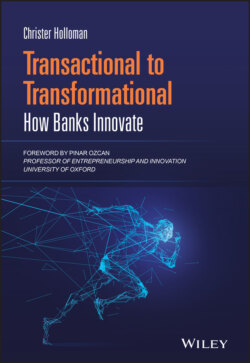Читать книгу Transactional to Transformational - Christer Holloman - Страница 7
Foreword
ОглавлениеOver their lifetime, banks have not been known for innovation. They have long held a privileged position of trust in society, as safeguards of our wealth and most private information. As such, customers have traditionally been happy with low rates of innovation, with almost 80% of us actively choosing to remain with the big traditional banks, despite financial incentive and regulatory support to switch. This was because, in the old world, we had accepted that security and innovation were an insurmountable trade‐off and that when given the choice, we would rather that our bank kept our money safe than give us more innovative technologies.
As you know very well if you are reading this book, this is no longer true. Following a perfect storm of events that shook both the industry players as well as the expectations of bank customers, we are now living in an age where banks have to compare themselves to, and collaborate with, small fintech and large tech companies in the race to satisfy their customers' needs.
In the events that led to this dramatic change in the banking industry, the 2008 global financial crisis has been considered a cornerstone. The crush of incumbent firms and the banking system led to the loss of customer trust, and the ripples of this shock continued for people who experienced financial losses in the crisis and the following economic downturn. Even though most big banks remained a safe place in people's eyes for keeping their financial assets, lack of transparency and persistent high fees caused a different kind of trust problem that banks needed to solve.
Another driver of the transformation of banks into innovative organisations has been their realisation of the different needs and habits of ‘millennials’ who are starting to become their customers. The differences in this generation's life goals, spending habits and employment patterns from previous generations are stark enough to make any organisation stop and think about reconfiguring their product portfolio. With lower home ownership rates, high student debt, variable employment and income, low trust in established institutions and, perhaps most importantly, high willingness to share their data for better services, millennials require not only a different set of financial services but also a much more data‐driven, personalised approach to their finances.
Finally, we must mention the buzz word, open banking, if we are to discuss innovation in banking. Open banking is a set of regulations that has been positioned as the catalyst for reinvention within the banking sector. Starting with the UK and EU in 2018, versions of open banking regulation are spreading fast around the world, with noteworthy examples in Australia, Brazil, Canada, India and Singapore. In a nutshell, open banking facilitates competition by mandating incumbent banks to produce open access to valuable current account and other financial data via application programming interfaces (APIs) to trusted third party providers. In other words, it gives customers control over their financial data and allows data‐driven new entrants to access the data they need in order to compete with big banks. Open banking has spurred competition to big banks, not only from small innovative fintechs but also from BigTech. Using the new regulations to access customers' bank data, the likes of Amazon, Google and Facebook are taking big strides into banking as I write this. Examples include Amazon's extension of credit to businesses on its platform via Amazon Lending, Facebook's aggressive implementation of P2P payments into its social platform and Google's announcement of basic banking (e.g. checking account) services starting in the US in 2021.
Against this backdrop, Christer Holloman's book on how banks innovate is both important and timely. Banks need to innovate in order to stay alive. However, it is not necessarily easy for them to do so given their legacy systems and safety‐focused culture. In this book, Christer provides an array of innovation efforts by top banks around the world. What I find particularly noteworthy here is the honest approach to the problems faced by these vast institutions. There is no magic pill for banks to become data‐driven technology organisations overnight; innovation takes constant effort and change in management. For those organisations that are at the start of this journey, Christer's book provides an open buffet of innovation efforts from the industry to consider and implement. These insights are not only valuable to other banks that are realising the need to start an aggressive innovation programme, but also to any big organisations that are being disrupted by data‐driven technology organisations.
Pinar Ozcan
Professor of Entrepreneurship & Innovation
Saïd Business School, University of Oxford
